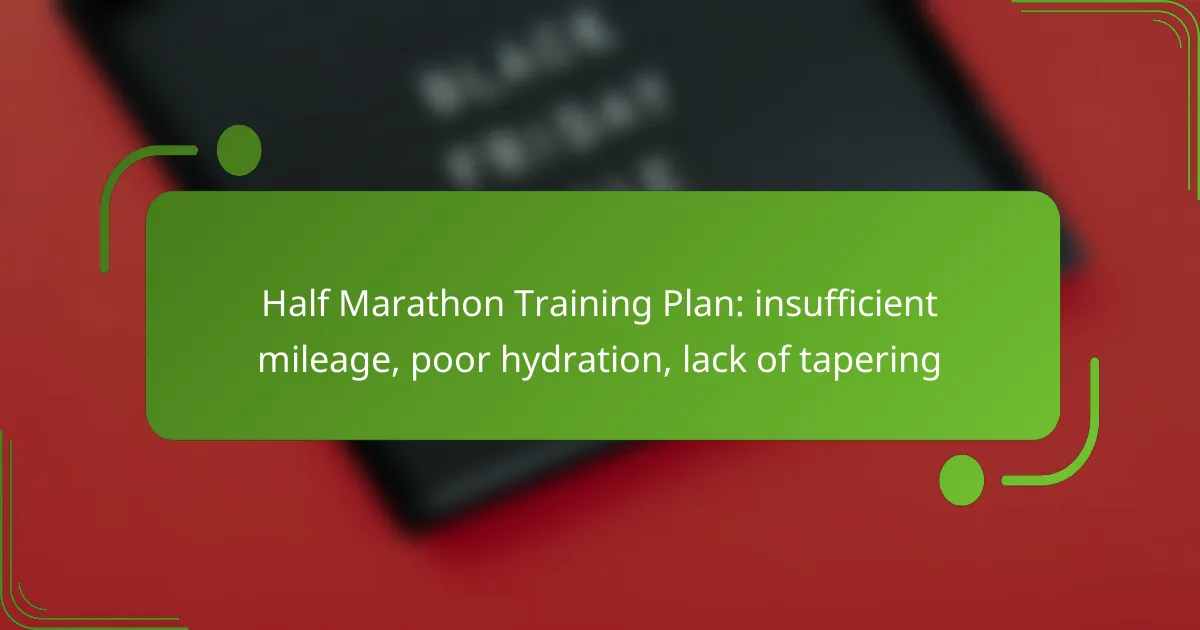Preparing for a half marathon requires careful attention to key factors such as mileage, hydration, and tapering. Insufficient mileage can hinder your endurance, while poor hydration may lead to decreased performance and increased injury risk. Additionally, a proper tapering phase is essential to allow your body to recover and perform at its best on race day.

How to increase mileage for half marathon training?
To effectively increase mileage for half marathon training, gradually build your weekly distance while ensuring proper recovery. This approach helps prevent injuries and enhances endurance, making your training more effective.
Gradual weekly mileage increase
Increasing your weekly mileage should be done slowly, typically by no more than 10% each week. This gradual approach allows your body to adapt to the increased demands without risking injury. For example, if you run 20 miles one week, aim for 22 miles the next week.
Monitor how your body responds to the increased mileage. If you experience persistent fatigue or pain, consider reducing your mileage or taking a recovery week to allow your body to heal.
Incorporate long runs
Long runs are essential for building endurance and should be included in your weekly training schedule. Aim to increase your long run by about a mile or two each week, reaching distances of 10 to 12 miles a few weeks before the race.
These runs should be done at a comfortable pace, allowing you to focus on time on your feet rather than speed. This helps your body adapt to the longer distances you’ll face during the half marathon.
Use a training app like Strava
Training apps like Strava can help you track your mileage and monitor your progress over time. These apps allow you to set goals, log your runs, and analyze your performance, making it easier to stay on track with your mileage increases.
Additionally, many apps offer community features, allowing you to connect with other runners for motivation and support. This can be particularly helpful when trying to maintain consistency in your training.
Join local running clubs
Joining a local running club can provide valuable support and accountability as you increase your mileage. Clubs often organize group runs, which can help you stay motivated and push your limits in a social environment.
Being part of a community can also expose you to experienced runners who can share tips and advice on how to effectively increase your mileage while minimizing injury risk.
Follow a structured plan
Adopting a structured training plan can help you systematically increase your mileage while incorporating rest and recovery. Many plans are available online, tailored to different experience levels and timeframes leading up to a half marathon.
Choose a plan that aligns with your current fitness level and schedule, ensuring it includes a mix of easy runs, long runs, and rest days. This balanced approach will help you build endurance safely and effectively.

What are effective hydration strategies?
Effective hydration strategies involve maintaining optimal fluid levels before, during, and after your runs. Proper hydration enhances performance, reduces the risk of injury, and aids recovery.
Pre-run hydration guidelines
Before a run, aim to drink about 500-600 ml of water or a sports drink at least two hours prior. This allows your body to absorb the fluids and helps prevent dehydration during your run.
In the hour leading up to your run, consume an additional 200-300 ml of water. Avoid excessive intake to prevent discomfort while running.
During-run hydration tips
During your run, especially if it lasts longer than an hour, aim to drink about 150-250 ml of fluid every 15-20 minutes. This can include water or a sports drink, depending on your needs.
Consider the weather conditions; in hot and humid environments, you may need to increase your fluid intake to compensate for higher sweat loss.
Post-run recovery drinks
After your run, focus on rehydrating with 500-700 ml of fluid within 30 minutes. A mix of water and electrolyte-rich drinks can help restore lost fluids and minerals.
Incorporating a recovery drink containing carbohydrates and protein can further aid in muscle recovery and replenish energy stores.
Use electrolyte supplements
Electrolyte supplements can be beneficial during long runs or in hot conditions. They help replace sodium, potassium, and other minerals lost through sweat.
Choose electrolyte tablets or powders that dissolve in water, and follow the recommended dosage to avoid overconsumption, which can lead to gastrointestinal issues.

How to properly taper before a half marathon?
Tapering before a half marathon involves reducing your training volume to allow your body to recover and prepare for race day. This process typically spans one to two weeks and is crucial for optimizing performance and minimizing fatigue.
Reduce mileage gradually
To effectively taper, start by gradually decreasing your weekly mileage. Aim to cut your total distance by about 20-30% in the first week and then by another 20-30% in the final week leading up to the race. For example, if you were running 30 miles per week, reduce it to around 21-24 miles in the first week and 15-18 miles in the last week.
Make sure to maintain your long run, but reduce its distance to about 60-70% of what you would typically run. This helps keep your endurance while allowing your body to recover.
Maintain intensity during taper
While reducing mileage, it’s important to maintain the intensity of your workouts. Include short tempo runs or interval sessions to keep your speed and strength sharp. These workouts should be shorter in duration but can be done at race pace or slightly faster.
A good approach is to incorporate one or two quality workouts each week, focusing on maintaining your race pace for short intervals, such as 3-5 minutes, followed by equal recovery time.
Focus on rest and recovery
Rest and recovery are essential components of a successful taper. Prioritize sleep and consider incorporating rest days or easy runs to allow your muscles to repair. Aim for at least 7-9 hours of sleep each night to support recovery.
Additionally, pay attention to your nutrition and hydration. Consume balanced meals rich in carbohydrates, lean proteins, and healthy fats, and ensure you are well-hydrated, especially in the days leading up to the race. Avoid trying new foods or supplements during this period to prevent any digestive issues on race day.

What are the common mistakes in half marathon training?
Common mistakes in half marathon training include insufficient mileage buildup, poor hydration practices, and neglecting the tapering period. These errors can hinder performance and increase the risk of injury, making it essential for runners to address them effectively.
Insufficient mileage buildup
Insufficient mileage buildup occurs when runners do not gradually increase their weekly distance, which is crucial for building endurance. A typical training plan should include a mix of shorter runs and longer runs, with a weekly mileage increase of about 10% to avoid injury.
For example, if your weekly mileage is around 20 miles, aim to increase it to approximately 22 miles the following week. Skipping long runs or failing to progressively increase distance can lead to fatigue and poor race performance.
Poor hydration practices
Poor hydration practices can significantly impact a runner’s performance during training and on race day. It’s essential to drink enough fluids before, during, and after runs to maintain optimal hydration levels.
A general guideline is to consume about 500-700 mL of water or electrolyte drink in the hours leading up to a run and to drink approximately 150-250 mL every 15-20 minutes during the run. Ignoring hydration can lead to decreased performance and increased risk of cramps or heat-related illnesses.
Neglecting tapering period
Neglecting the tapering period means failing to reduce training intensity and volume in the weeks leading up to the race. Tapering is crucial for allowing the body to recover and store energy for optimal performance on race day.
A typical taper lasts about one to two weeks, where you gradually decrease your mileage by 20-30%. This strategy helps to ensure that you feel fresh and ready to tackle the half marathon without the fatigue of overtraining.

What are the benefits of a structured training plan?
A structured training plan provides a clear roadmap for runners, ensuring they build endurance and speed effectively while minimizing risks. By following a systematic approach, athletes can optimize their performance and achieve their race goals with greater ease.
Improved performance
A structured training plan enhances performance by gradually increasing mileage and intensity, allowing the body to adapt over time. This method helps runners develop a strong aerobic base and improve their speed, often resulting in better race times.
For instance, incorporating interval training and tempo runs into a weekly schedule can lead to significant gains in pace. Runners should aim for a mix of easy runs, long runs, and speed workouts to maximize their potential.
Injury prevention
Following a structured training plan reduces the risk of injuries by promoting gradual increases in mileage and ensuring adequate recovery. This approach helps prevent overuse injuries, which are common among runners who increase their training too quickly.
Key strategies include incorporating rest days, cross-training, and strength training to support muscle balance and joint stability. Runners should listen to their bodies and adjust their plans if they experience pain or fatigue.
Enhanced motivation
A structured training plan can boost motivation by setting clear, achievable goals and providing a sense of progress. When runners can track their improvements and celebrate milestones, they are more likely to stay committed to their training.
To maintain motivation, consider joining a running group or participating in local races. Setting short-term goals, such as completing a certain number of miles each week, can also keep runners engaged and focused on their training journey.
